选择性必修三 Unit 5 Poems - Using Language 2(37张PPT)
文档属性
| 名称 | 选择性必修三 Unit 5 Poems - Using Language 2(37张PPT) |
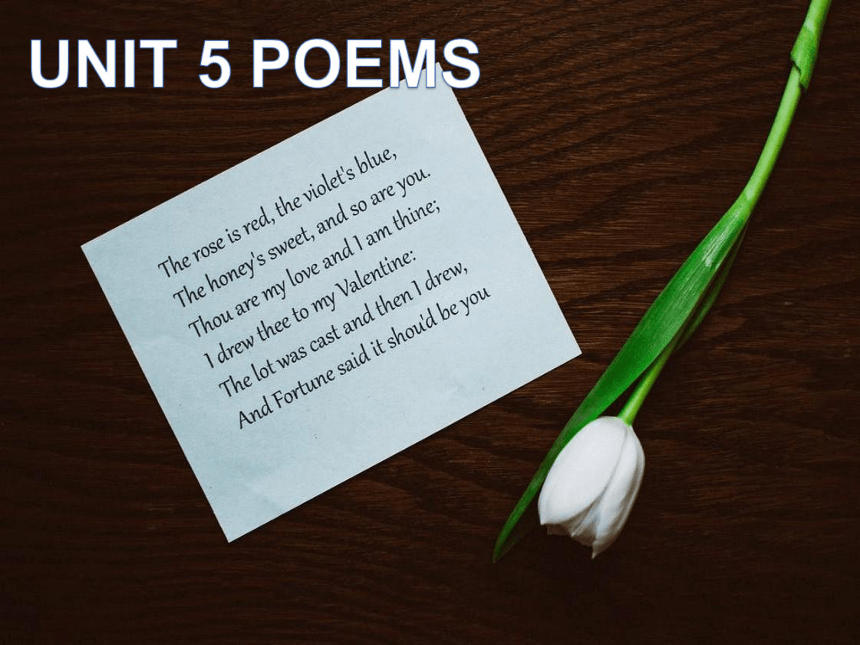
|
|
| 格式 | pptx | ||
| 文件大小 | 2.1MB | ||
| 资源类型 | 试卷 | ||
| 版本资源 | 人教版(2019) | ||
| 科目 | 英语 | ||
| 更新时间 | 2022-02-05 19:02:57 | ||
图片预览

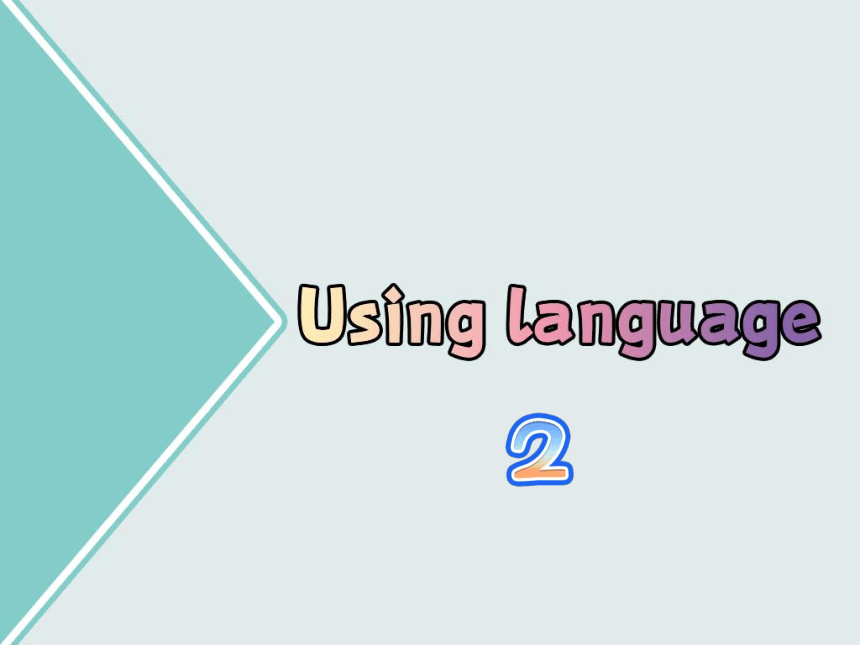
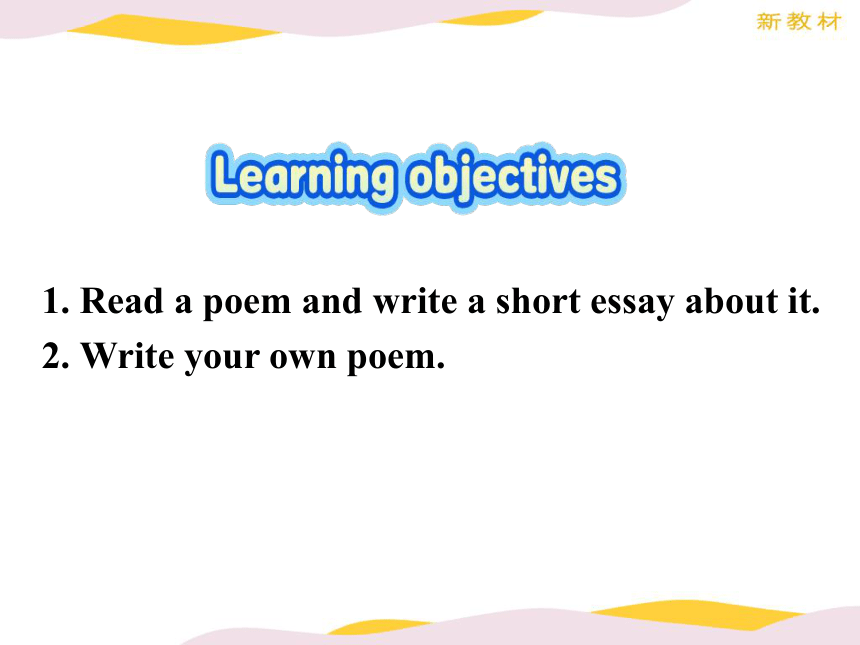
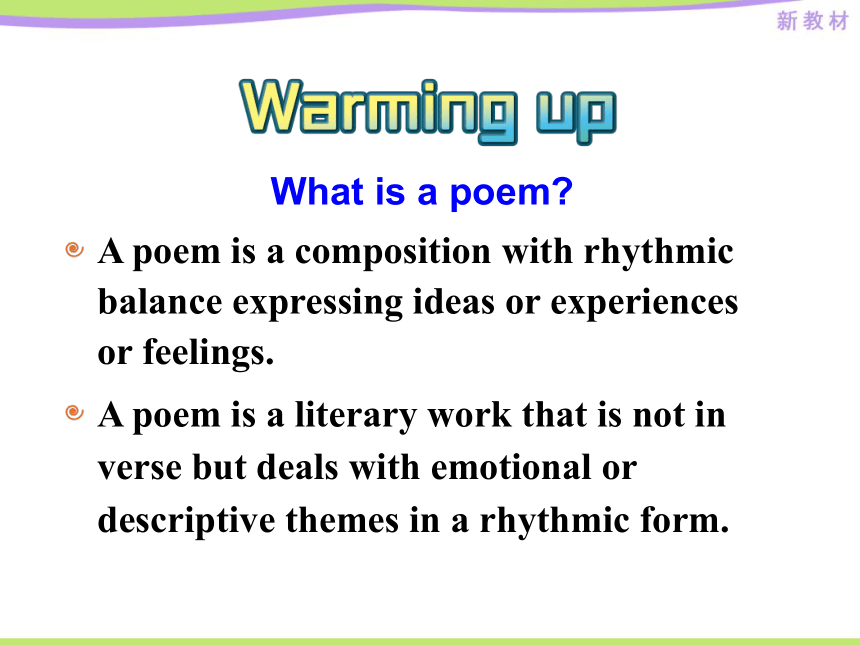
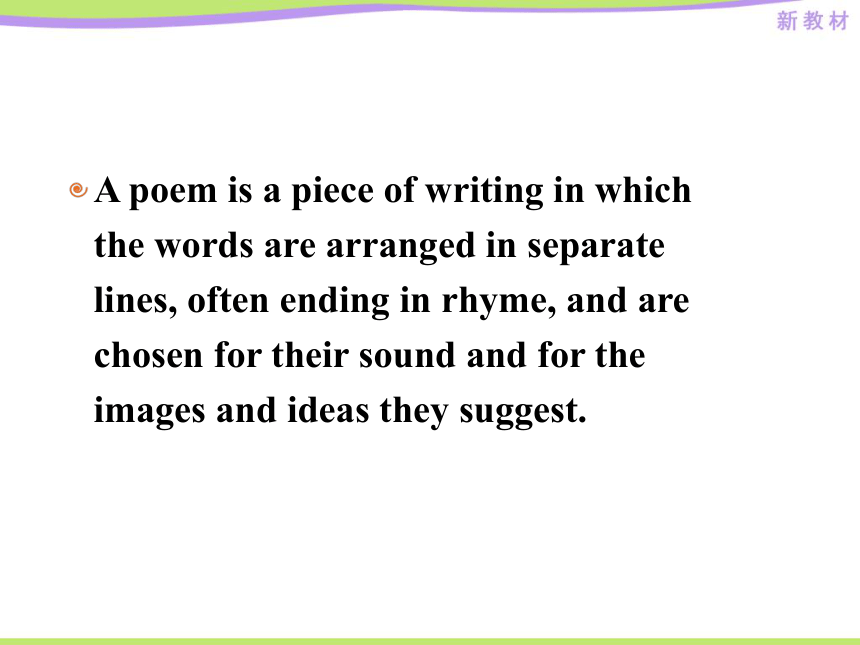
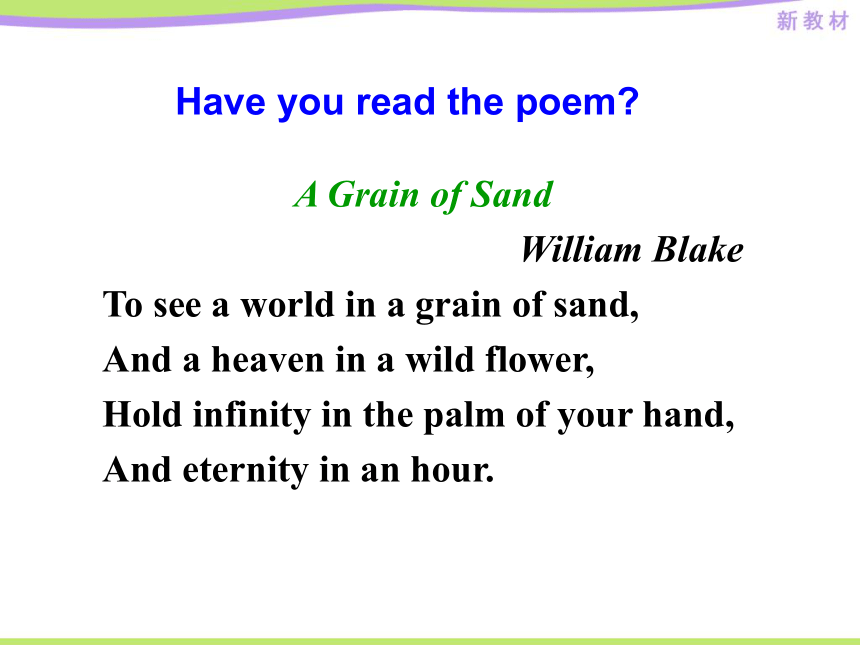
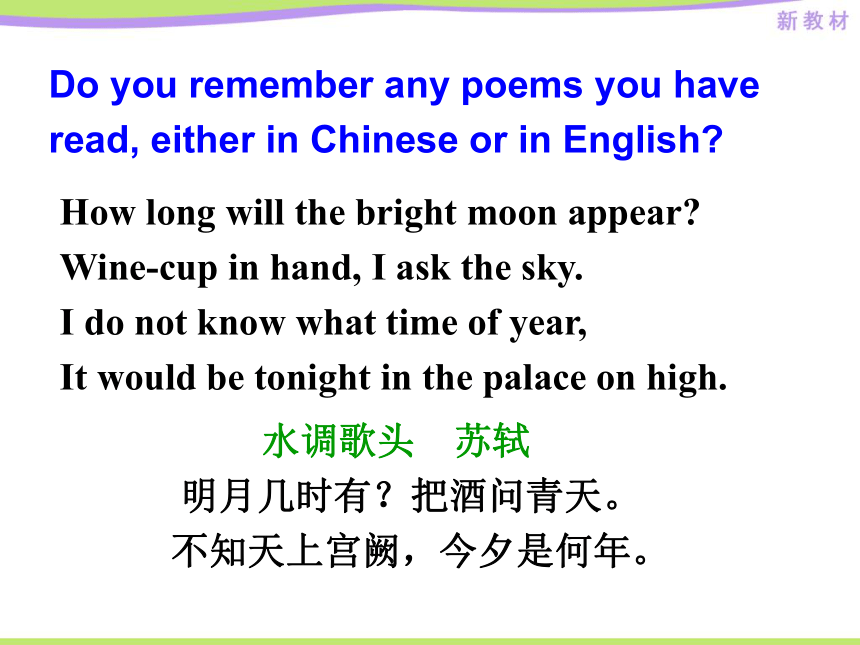
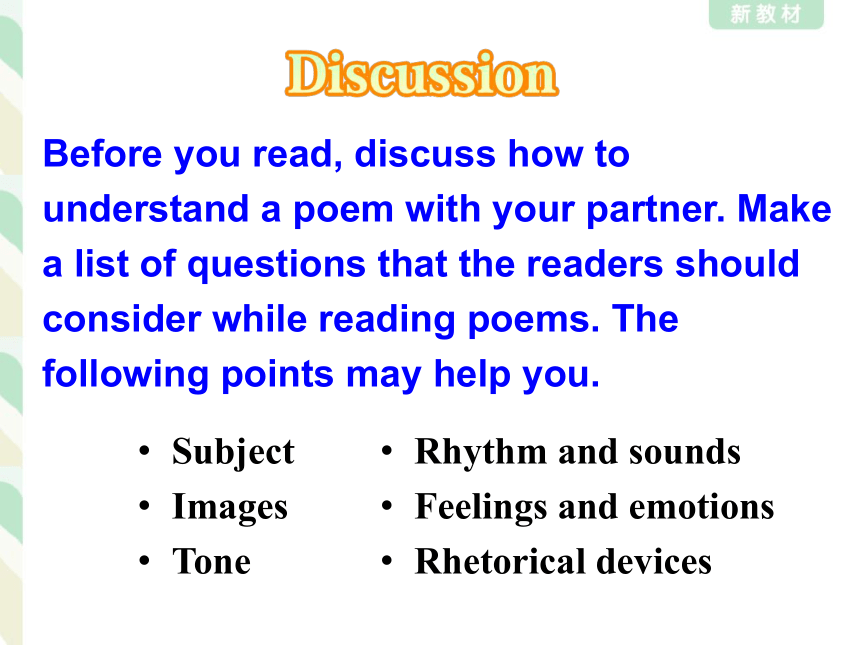
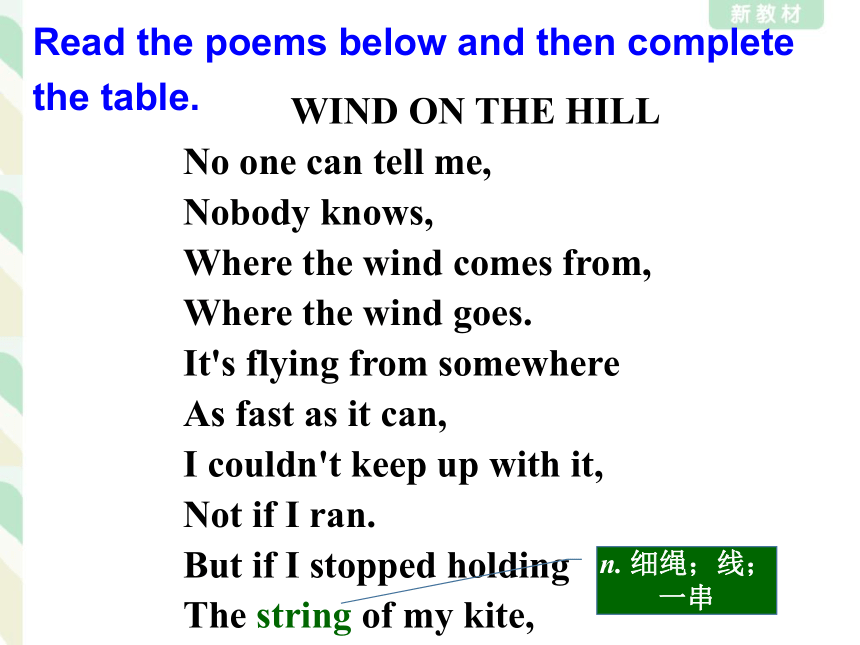
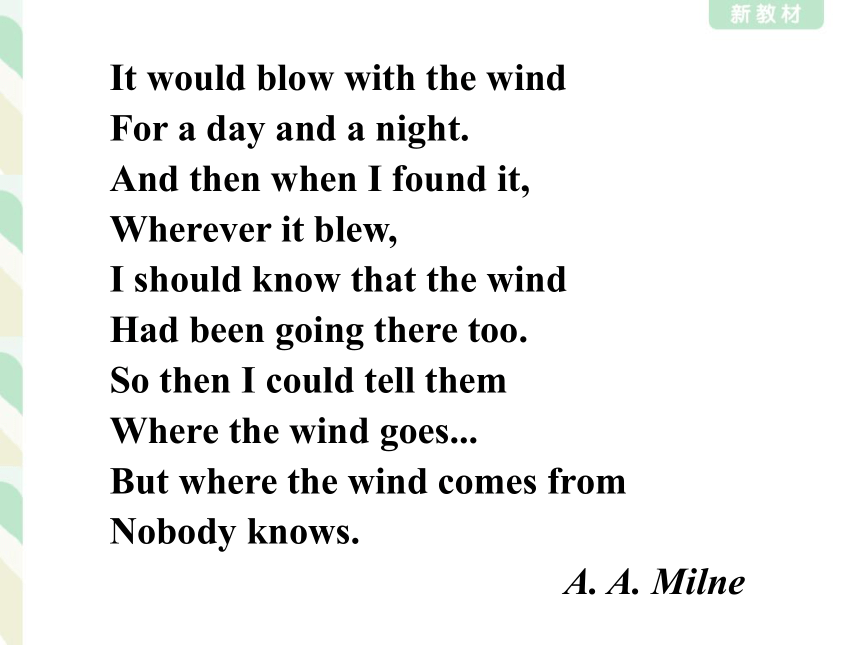
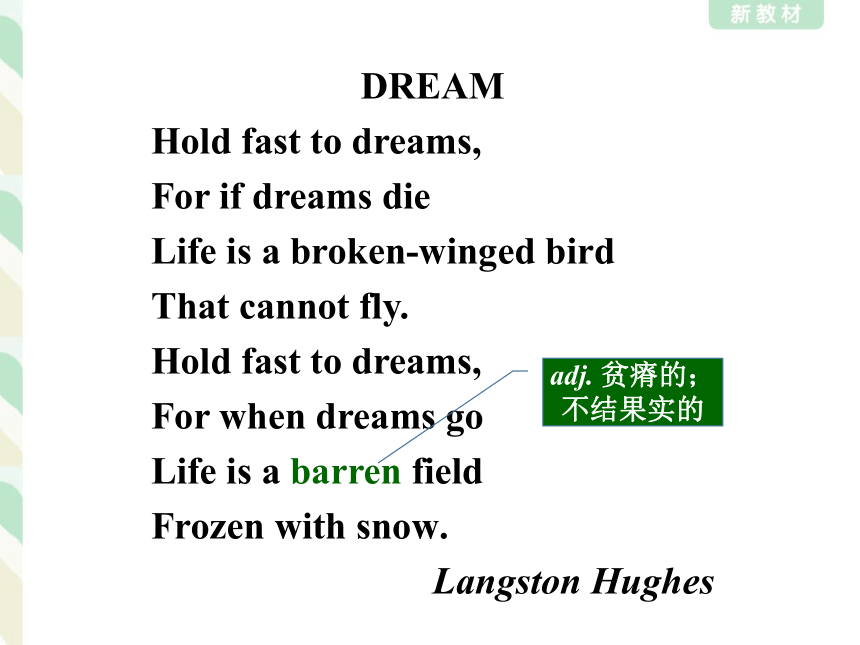
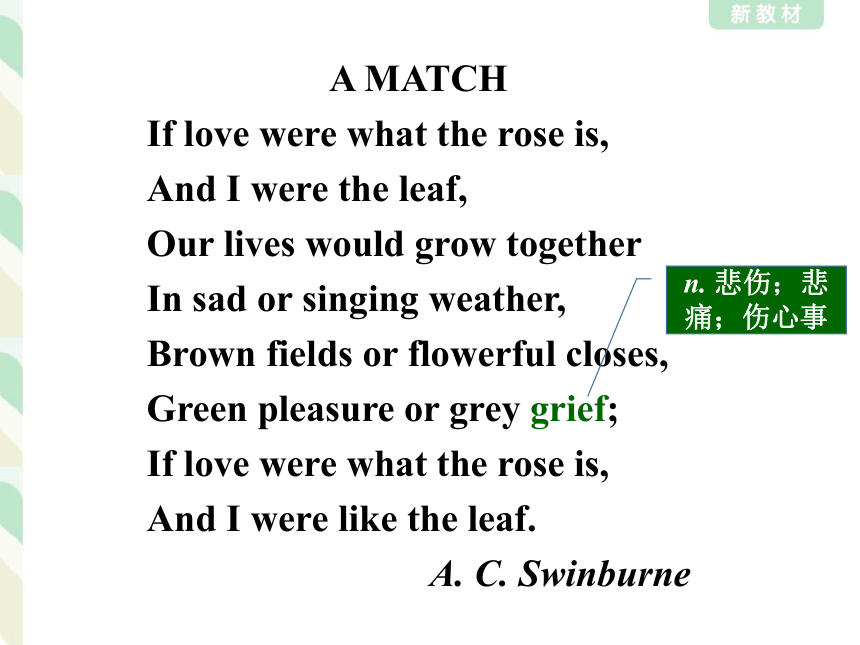
文档简介
(共37张PPT)
UNIT 5 POEMS
1. Read a poem and write a short essay about it.
2. Write your own poem.
What is a poem
A poem is a composition with rhythmic
balance expressing ideas or experiences
or feelings.
A poem is a literary work that is not in verse but deals with emotional or
descriptive themes in a rhythmic form.
A poem is a piece of writing in which
the words are arranged in separate
lines, often ending in rhyme, and are
chosen for their sound and for the
images and ideas they suggest.
A Grain of Sand
William Blake
To see a world in a grain of sand,
And a heaven in a wild flower,
Hold infinity in the palm of your hand,
And eternity in an hour.
Have you read the poem
Do you remember any poems you have read, either in Chinese or in English
How long will the bright moon appear Wine-cup in hand, I ask the sky.
I do not know what time of year,
It would be tonight in the palace on high.
水调歌头 苏轼
明月几时有?把酒问青天。
不知天上宫阙,今夕是何年。
Before you read, discuss how to understand a poem with your partner. Make a list of questions that the readers should consider while reading poems. The following points may help you.
Subject
Images
Tone
Rhythm and sounds
Feelings and emotions
Rhetorical devices
Read the poems below and then complete the table.
WIND ON THE HILL
No one can tell me,
Nobody knows,
Where the wind comes from,
Where the wind goes.
It's flying from somewhere
As fast as it can,
I couldn't keep up with it,
Not if I ran.
But if I stopped holding
The string of my kite,
n. 细绳;线;一串
It would blow with the wind
For a day and a night.
And then when I found it,
Wherever it blew,
I should know that the wind
Had been going there too.
So then I could tell them
Where the wind goes...
But where the wind comes from
Nobody knows.
A. A. Milne
DREAM
Hold fast to dreams,
For if dreams die
Life is a broken-winged bird
That cannot fly.
Hold fast to dreams,
For when dreams go
Life is a barren field
Frozen with snow.
Langston Hughes
adj. 贫瘠的;不结果实的
A MATCH
If love were what the rose is,
And I were the leaf,
Our lives would grow together
In sad or singing weather,
Brown fields or flowerful closes,
Green pleasure or grey grief;
If love were what the rose is,
And I were like the leaf.
A. C. Swinburne
n. 悲伤;悲痛;伤心事
Wind on the Hill Dream A Match
Subject
Images
wind
Where the wind
comes from and
goes
dream
Hold fast to dreams
love
If love were what the rose is
Wind on the Hill Dream A Match
Rhyming words
Rhetorical devices
knows, goes, can, ran
personification
die, fly,
go, snow
metaphor
leaf, grief
metaphor
Choose one of the poems and write a short essay about it. The following example may help you.
The poem Dream by Langston Hughes is very short with only 8 lines. When I read the poem aloud I can hear that the ends of the second and fourth sentences rhyme — “die” and “fly”. The last word from the sixth and eighth sentences also rhyme— “go” and “snow”. These rhyming words sound nice and make the poem pleasing to read.
When I close my eyes, I can see different images from the poem. For example, I can see two hands being held【1】. I can see a bird flying in the sky【2】. I can see a field and I can imagine what it looks like with lots of snow. I start to feel cold when I read these lines!
【1】画线部分为"感官动词+宾语+宾补"结构,being held为过去分词的进行式作宾补,表示正在进行的被动动作。
【2】画线部分为"感官动词+宾语+宾补"结构,现在分词短语在此作宾补,表示正在进行的主动动作。
I learnt a new phrase, “hold fast”, which means to hold onto something. “Barren” is also a new word to me, which means empty.
I think the poet is giving us advice. He wants us to keep dreaming, because life is much better when we dream and have something to look forward to.
How to write a short essay about a poem
如何写诗歌赏析类文章
写法一: 通过对全诗的整体分析,表达自己的观点 写法二:
就诗歌最突出的方面进行分析,表达自己的见解。
写法一
一篇较完整的诗歌赏析类文章包含如下内容:
4.
作品的艺术手法分析
(通常结合在作品意向分析之中)
5.
作品艺术特点的综合评价
(常带有总结的意味)
写法二
采用这种写法时,作者只需要抓住其中一个方面,如意境、语言表达、某一手法等。对于其他方面则可不提及,因而采用这种写法的文章篇幅一般较短小。
体 裁 人 称 时 态 要 点 结 构 图 开头 点题 提炼出诗歌中所包含的信息。
议论文 第三人称为主 1. 一般现在时 2. 一般过去时 主体 段落 多种方式表达,层次分明,结构清晰,过渡自然。
结尾 针对诗歌中所提供的信息,发表自己的观点。
写作布局
4.
作品的艺术手法分析
(通常结合在作品意向分析之中)
5.
作品艺术特点的综合评价
(常带有总结的意味)
Here is a poem titled ... by...
It is popular with Chinese readers.
This poem is about nature and life.
It is written with special writing skills.
It rhymes at the end of each line.
The language of the poem is descriptive and vivid.
4.
作品的艺术手法分析
(通常结合在作品意向分析之中)
Whenever we read this poem, some characters appear clearly.
Only by reading it repeatedly can we grasp the spirit of this poem.
Considered as one of the greatest poets of the Tang Dynasty,… will undoubtedly live in people’s heart forever.
In my opinion, the young generation today should understand and learnt form the poem.
Write your own poem by following these steps.
Start with the theme first. Ask yourself, “What message do I want to give to the reader What is important to me ”
Next, think about the words and phrases you would like to use. Make a list of words related to your theme.
Then check how well your details paint a picture in your need. Now write the poem. Read it aloud and listen to how it sounds.
Finally, give it a title. Now your poem is ready!
诗歌是高度概括、反映社会生活的文学体裁,也是最富有激情和感彩的体裁。诗歌往往用高度凝练的语言来表达诗人的喜怒哀乐,诗人把自己对生活和客观世界的理解和感悟融入诗中。诗歌可以以其特有的节奏与方式影响人们的精神世界,饱含着作者丰富的思想感情。
如何写英文诗歌
1. 目的明确。人们写诗歌出于各种各样的目的,有的是为了讲述一个故事,有的是为了表达感情,有的是为了描述事物等等。
2. 内容充实。诗歌要言之有物,传达出作者对外在世界的独特感受,所表现的题材要有深刻丰富的内心体验。
3. 形式适当。在写诗歌时要注意选择一种既能实现写作目的又能驾驭的形式。
五行诗。第一行:一个名词(主题);第二行:两个形容词(描写主题);第三行:三个动词-ing形式(与主题相关的动作);第四行:四个词(作者感受);第五行:一个词(回归主题)。
Kitty
Naughty, sleepy
Chasing, tearing, licking
Day in, night out
Meow
清单诗。可长可短,可以重复一些短语,形成固定句型和诗的节奏。可以有韵脚,也可以没有。
What moves me
It moves me ...
When my family around the table have holiday feasts.
When my father mends my bicycle with oil-covered hands.
When my mother waits a long time for me at the school gate.
When my grandpa holds Grandma’s hands while crossing the street.
When my sister sings a sweet lullaby (摇篮曲) to her baby.
When my pet cat licks her kittens softly.
4. 语言得当。诗歌的语言不同于我们的日常用语,也不同于一般的小说和散文的语言。诗人只有对实用语言加以“破坏、改造”,如英国著名诗人艾略特所说的那样“扭断语法的脖子”,才能使之成为诗歌的语言。
5. 有节奏感。在语言的外观上,诗歌通常是以分行排列的方式呈现,且要有和谐的音韵,鲜明的节奏。诗歌的押韵是指通过重复元音或辅音以达到一定的音韵效果,一首诗歌的押韵具有一定的规律,尤其是在诗句的末尾,即尾韵。
Spring, the sweet Spring, is the year’s pleasant king;
Then blooms each thing, then maids dance in a ring,
Cold doth not sting, the pretty birds do sing,
Cuckoo, jug-jug, pu-we, to-witta-woo!
(Spring by Thomas Nash)
Now write your poem.
There once was a boy who thought,
He could eat all the sweets he had bought.
He gobbled them down,
Then started to frown,
‘Cause he’d eaten more than he ought.
Take turns to read aloud your poems and then have a discussion on what you think they mean. Give your personal opinion or advice based on what you have learnt from this unit.
Read aloud your poem to the class or put it up in the classroom.
Revise your poem with the help of your group members or what you have learnt from this unit.
Share your poem with the class and put it up in the classroom.
UNIT 5 POEMS
1. Read a poem and write a short essay about it.
2. Write your own poem.
What is a poem
A poem is a composition with rhythmic
balance expressing ideas or experiences
or feelings.
A poem is a literary work that is not in verse but deals with emotional or
descriptive themes in a rhythmic form.
A poem is a piece of writing in which
the words are arranged in separate
lines, often ending in rhyme, and are
chosen for their sound and for the
images and ideas they suggest.
A Grain of Sand
William Blake
To see a world in a grain of sand,
And a heaven in a wild flower,
Hold infinity in the palm of your hand,
And eternity in an hour.
Have you read the poem
Do you remember any poems you have read, either in Chinese or in English
How long will the bright moon appear Wine-cup in hand, I ask the sky.
I do not know what time of year,
It would be tonight in the palace on high.
水调歌头 苏轼
明月几时有?把酒问青天。
不知天上宫阙,今夕是何年。
Before you read, discuss how to understand a poem with your partner. Make a list of questions that the readers should consider while reading poems. The following points may help you.
Subject
Images
Tone
Rhythm and sounds
Feelings and emotions
Rhetorical devices
Read the poems below and then complete the table.
WIND ON THE HILL
No one can tell me,
Nobody knows,
Where the wind comes from,
Where the wind goes.
It's flying from somewhere
As fast as it can,
I couldn't keep up with it,
Not if I ran.
But if I stopped holding
The string of my kite,
n. 细绳;线;一串
It would blow with the wind
For a day and a night.
And then when I found it,
Wherever it blew,
I should know that the wind
Had been going there too.
So then I could tell them
Where the wind goes...
But where the wind comes from
Nobody knows.
A. A. Milne
DREAM
Hold fast to dreams,
For if dreams die
Life is a broken-winged bird
That cannot fly.
Hold fast to dreams,
For when dreams go
Life is a barren field
Frozen with snow.
Langston Hughes
adj. 贫瘠的;不结果实的
A MATCH
If love were what the rose is,
And I were the leaf,
Our lives would grow together
In sad or singing weather,
Brown fields or flowerful closes,
Green pleasure or grey grief;
If love were what the rose is,
And I were like the leaf.
A. C. Swinburne
n. 悲伤;悲痛;伤心事
Wind on the Hill Dream A Match
Subject
Images
wind
Where the wind
comes from and
goes
dream
Hold fast to dreams
love
If love were what the rose is
Wind on the Hill Dream A Match
Rhyming words
Rhetorical devices
knows, goes, can, ran
personification
die, fly,
go, snow
metaphor
leaf, grief
metaphor
Choose one of the poems and write a short essay about it. The following example may help you.
The poem Dream by Langston Hughes is very short with only 8 lines. When I read the poem aloud I can hear that the ends of the second and fourth sentences rhyme — “die” and “fly”. The last word from the sixth and eighth sentences also rhyme— “go” and “snow”. These rhyming words sound nice and make the poem pleasing to read.
When I close my eyes, I can see different images from the poem. For example, I can see two hands being held【1】. I can see a bird flying in the sky【2】. I can see a field and I can imagine what it looks like with lots of snow. I start to feel cold when I read these lines!
【1】画线部分为"感官动词+宾语+宾补"结构,being held为过去分词的进行式作宾补,表示正在进行的被动动作。
【2】画线部分为"感官动词+宾语+宾补"结构,现在分词短语在此作宾补,表示正在进行的主动动作。
I learnt a new phrase, “hold fast”, which means to hold onto something. “Barren” is also a new word to me, which means empty.
I think the poet is giving us advice. He wants us to keep dreaming, because life is much better when we dream and have something to look forward to.
How to write a short essay about a poem
如何写诗歌赏析类文章
写法一: 通过对全诗的整体分析,表达自己的观点 写法二:
就诗歌最突出的方面进行分析,表达自己的见解。
写法一
一篇较完整的诗歌赏析类文章包含如下内容:
4.
作品的艺术手法分析
(通常结合在作品意向分析之中)
5.
作品艺术特点的综合评价
(常带有总结的意味)
写法二
采用这种写法时,作者只需要抓住其中一个方面,如意境、语言表达、某一手法等。对于其他方面则可不提及,因而采用这种写法的文章篇幅一般较短小。
体 裁 人 称 时 态 要 点 结 构 图 开头 点题 提炼出诗歌中所包含的信息。
议论文 第三人称为主 1. 一般现在时 2. 一般过去时 主体 段落 多种方式表达,层次分明,结构清晰,过渡自然。
结尾 针对诗歌中所提供的信息,发表自己的观点。
写作布局
4.
作品的艺术手法分析
(通常结合在作品意向分析之中)
5.
作品艺术特点的综合评价
(常带有总结的意味)
Here is a poem titled ... by...
It is popular with Chinese readers.
This poem is about nature and life.
It is written with special writing skills.
It rhymes at the end of each line.
The language of the poem is descriptive and vivid.
4.
作品的艺术手法分析
(通常结合在作品意向分析之中)
Whenever we read this poem, some characters appear clearly.
Only by reading it repeatedly can we grasp the spirit of this poem.
Considered as one of the greatest poets of the Tang Dynasty,… will undoubtedly live in people’s heart forever.
In my opinion, the young generation today should understand and learnt form the poem.
Write your own poem by following these steps.
Start with the theme first. Ask yourself, “What message do I want to give to the reader What is important to me ”
Next, think about the words and phrases you would like to use. Make a list of words related to your theme.
Then check how well your details paint a picture in your need. Now write the poem. Read it aloud and listen to how it sounds.
Finally, give it a title. Now your poem is ready!
诗歌是高度概括、反映社会生活的文学体裁,也是最富有激情和感彩的体裁。诗歌往往用高度凝练的语言来表达诗人的喜怒哀乐,诗人把自己对生活和客观世界的理解和感悟融入诗中。诗歌可以以其特有的节奏与方式影响人们的精神世界,饱含着作者丰富的思想感情。
如何写英文诗歌
1. 目的明确。人们写诗歌出于各种各样的目的,有的是为了讲述一个故事,有的是为了表达感情,有的是为了描述事物等等。
2. 内容充实。诗歌要言之有物,传达出作者对外在世界的独特感受,所表现的题材要有深刻丰富的内心体验。
3. 形式适当。在写诗歌时要注意选择一种既能实现写作目的又能驾驭的形式。
五行诗。第一行:一个名词(主题);第二行:两个形容词(描写主题);第三行:三个动词-ing形式(与主题相关的动作);第四行:四个词(作者感受);第五行:一个词(回归主题)。
Kitty
Naughty, sleepy
Chasing, tearing, licking
Day in, night out
Meow
清单诗。可长可短,可以重复一些短语,形成固定句型和诗的节奏。可以有韵脚,也可以没有。
What moves me
It moves me ...
When my family around the table have holiday feasts.
When my father mends my bicycle with oil-covered hands.
When my mother waits a long time for me at the school gate.
When my grandpa holds Grandma’s hands while crossing the street.
When my sister sings a sweet lullaby (摇篮曲) to her baby.
When my pet cat licks her kittens softly.
4. 语言得当。诗歌的语言不同于我们的日常用语,也不同于一般的小说和散文的语言。诗人只有对实用语言加以“破坏、改造”,如英国著名诗人艾略特所说的那样“扭断语法的脖子”,才能使之成为诗歌的语言。
5. 有节奏感。在语言的外观上,诗歌通常是以分行排列的方式呈现,且要有和谐的音韵,鲜明的节奏。诗歌的押韵是指通过重复元音或辅音以达到一定的音韵效果,一首诗歌的押韵具有一定的规律,尤其是在诗句的末尾,即尾韵。
Spring, the sweet Spring, is the year’s pleasant king;
Then blooms each thing, then maids dance in a ring,
Cold doth not sting, the pretty birds do sing,
Cuckoo, jug-jug, pu-we, to-witta-woo!
(Spring by Thomas Nash)
Now write your poem.
There once was a boy who thought,
He could eat all the sweets he had bought.
He gobbled them down,
Then started to frown,
‘Cause he’d eaten more than he ought.
Take turns to read aloud your poems and then have a discussion on what you think they mean. Give your personal opinion or advice based on what you have learnt from this unit.
Read aloud your poem to the class or put it up in the classroom.
Revise your poem with the help of your group members or what you have learnt from this unit.
Share your poem with the class and put it up in the classroom.
